Since winning the 2021 Championship Play-Off Final, all eyes have been on Brentford and Thomas Frank. Their data-driven recruitment model has been lauded by many, and alongside the manager’s tactical acumen, has seen The Bees record a 13th-place finish in their first season in the top flight as well as an impressive ninth-place finish last season.
Brentford have their own way of doing things. They didn’t rush out and spend millions on players that won’t fit into their system; they made informed choices about transfers; the signing of Kristoffer Ajer from Celtic in their first season in the top flight went a long way towards keeping them in the league. In addition to making intelligent signings, Thomas Frank has shown himself to be one of the league’s most tactically flexible and astute managers.
Even after comfortably retaining Premier League status, Brentford haven’t gone out and made a whole host of signings. Instead, they have only chosen to bring in players they know will improve the team. The acquisition of Ben Mee on a free transfer has paid dividends, as he was instrumental in their top-half finish last season.
In this tactical analysis, we will look into the tactics that Thomas Frank has implemented at Brentford. This team-based scout report will provide an analysis of their performance last season and what to expect from Brentford ahead of the new Premier League campaign.
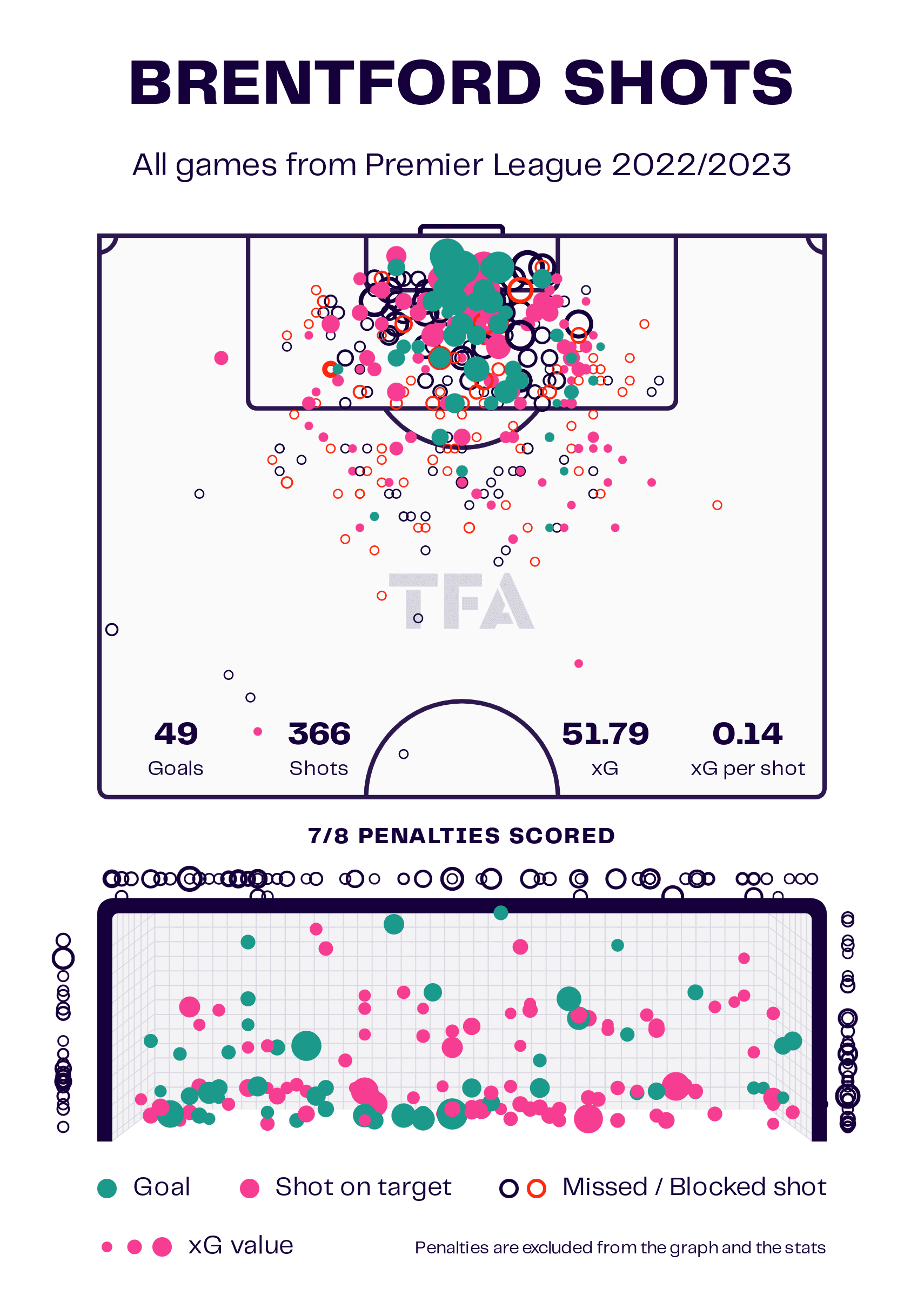
The Bees netted 58 times during the 2022/23 campaign, with Ivan Toney scoring 20, a fantastic goal return from their star man. From the data visual above, we can see that Brentford had an xG of 51.79, so they outperformed it by a fair amount, meaning they certainly scored some lower percentage chances.
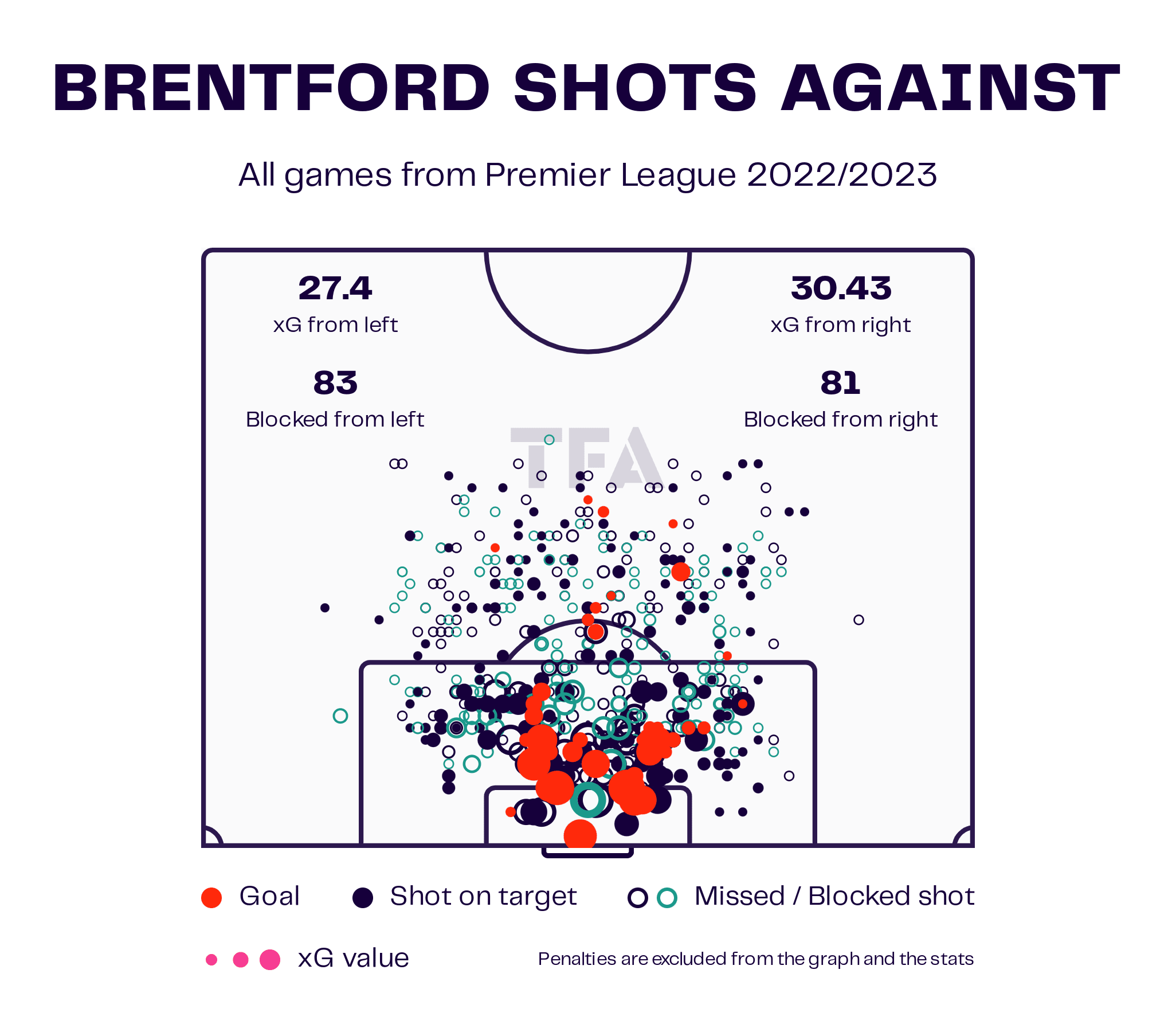
From the data visual above, we can see that Brentford conceded a total xG of 57.83, with slightly more or better goalscoring opportunities being generated on their right-hand side. We can also see that quite a few goals are being conceded from outside the area, which are lower percentage opportunities, so this could be an area for improvement during next season.
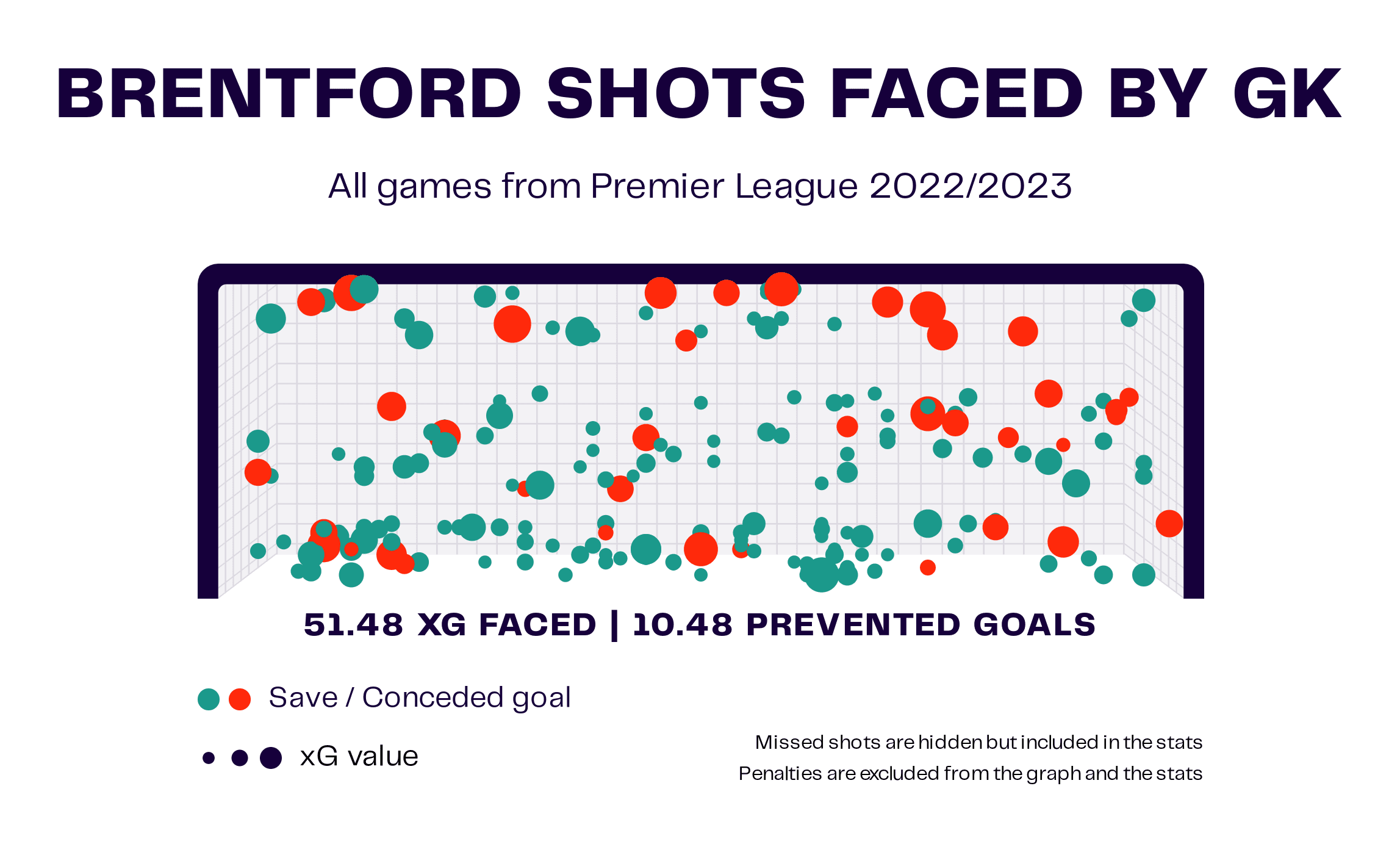
David Raya enjoyed an exceptional season in goal for Brentford, so it’s no surprise to see his name being linked with a move away from the Gtech Community Stadium. The Spanish goalkeeper was ever present for all 38 Premier League games, conceding 1.09 goals per 90 from an xCG of 1.22. As we can see from the data viz, this translated to 10.48 goals prevented over the course of the season.
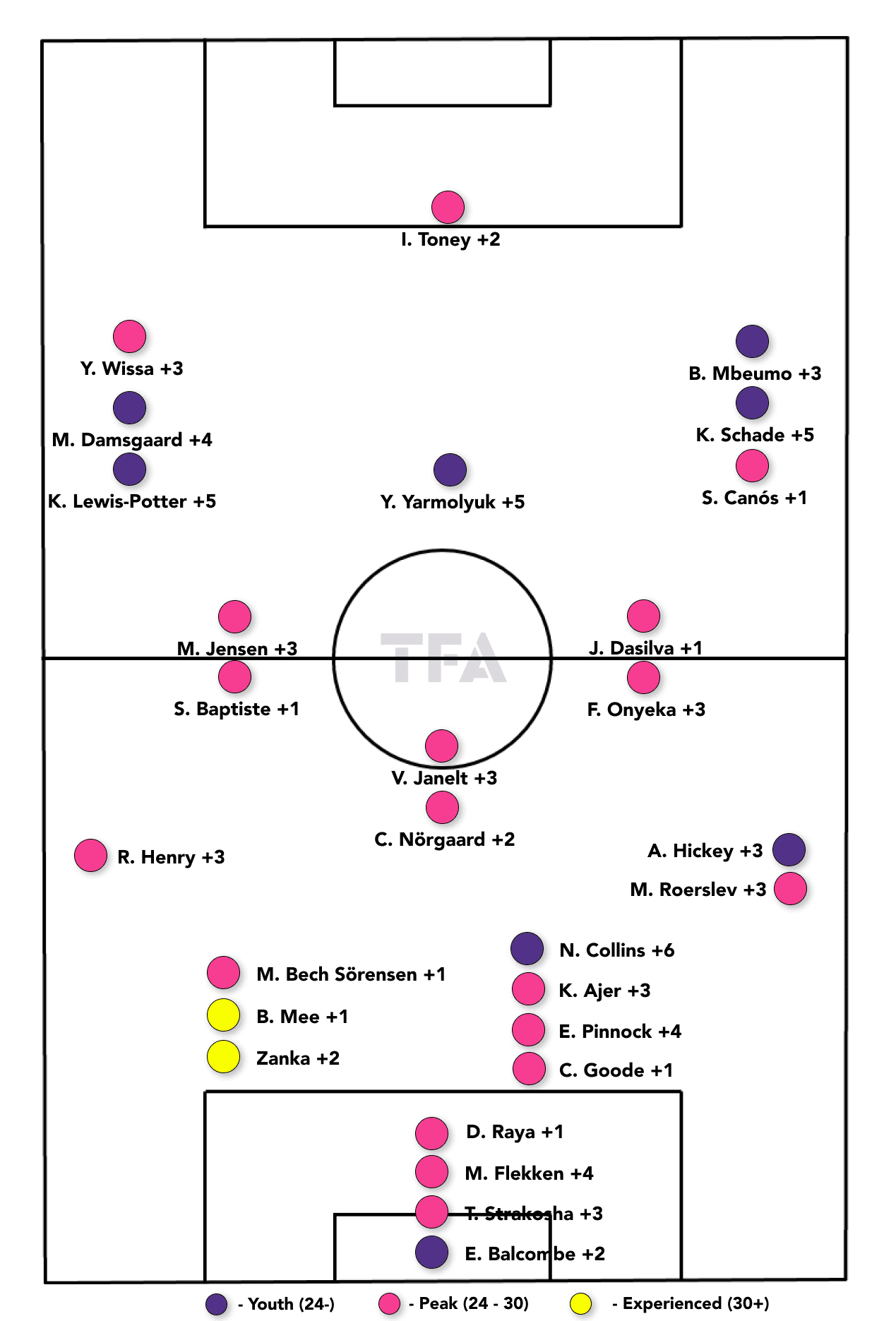
All eyes will be on Thomas Frank’s team ahead of the new season, especially as they almost reached the European places last year, and many will want to see if they can follow in the footsteps of Brighton.
They have already spent bigger than ever before, having activated their £22m option to buy Kevin Schade, who fans already know well as he spent the second half of last season on loan at the Gtech Community Stadium.
The Bees have also brought in Wolves central defender Nathan Collins for the sum of £23m as well as goalkeeper Mark Flekken from SC Freiburg for around £11m.
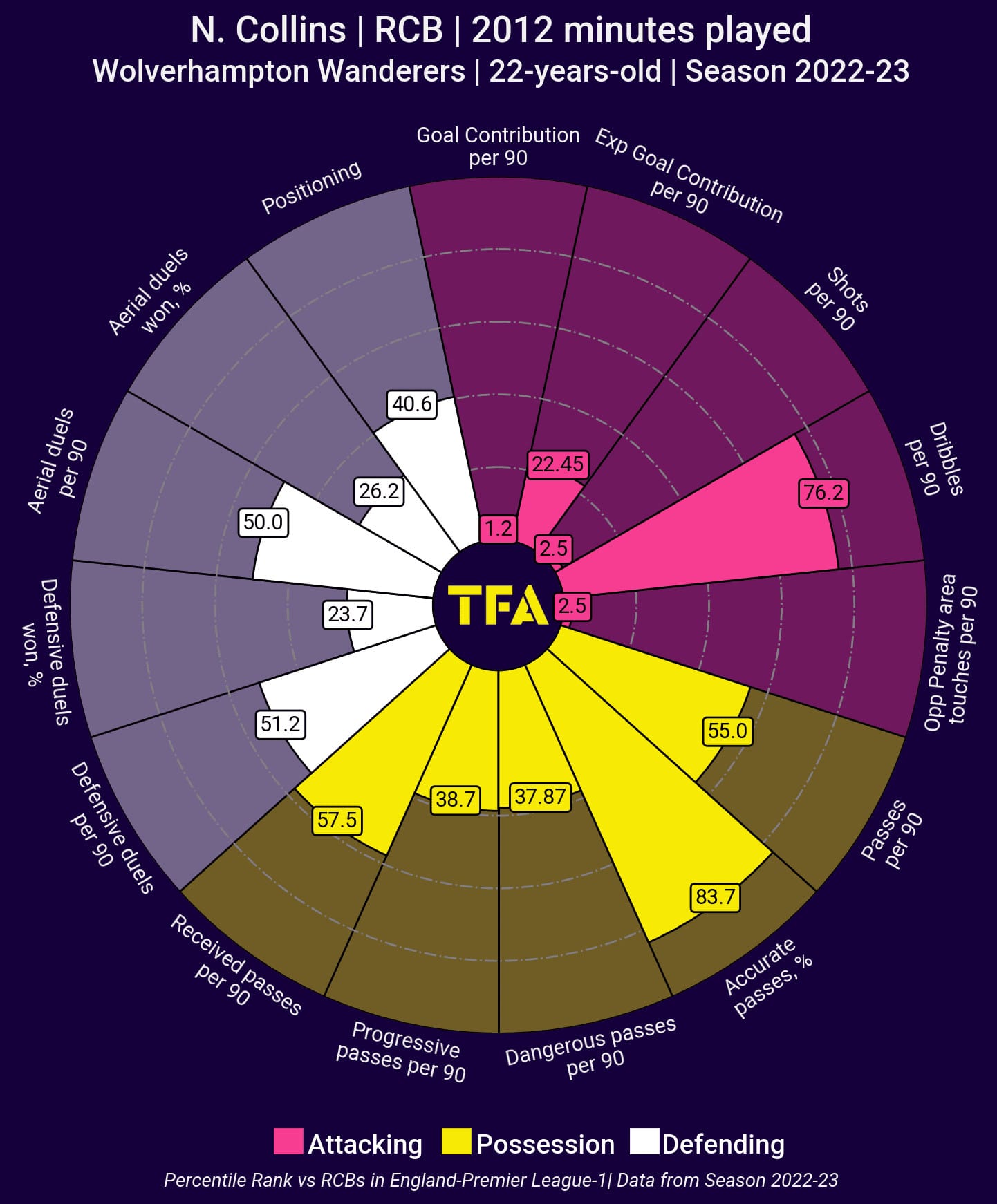
As mentioned above, The Bees have already spent big this transfer window, breaking their club record to bring in former Wolves man Nathan Collins. The Irish defender broke through into the Stoke first team back in 2019, where he went on to make over 40 appearances for The Potters before joining Burnley in 2021.
Collins became an integral member of Sean Dyche’s squad as they attempted to avoid relegation. After a tough time at Wolves, Collins will be looking to kick on and recapture some of his best form.
From the pizza chart above, Collins is pretty good on the ball with his passing and pass accuracy percentile rankings; this could be useful for Thomas Frank as it means Collins can be relied upon when distributing the ball.
Interestingly, he ranks highly in dribbles per 90, indicating he is comfortable carrying the ball. Perhaps this could mean Brentford don’t always have to play it long to clear their lines.
Brentford tend to do their transfer business quietly; we rarely hear constant rumours about the comings and goings at the Gtech Community Stadium. The Bees lack creativity in central midfield, where they could do with some more reinforcements if they are looking to challenge for European places.
Using our team xGold tool, we found that Atletico Madrid’s Pablo Barrios is ranked as having an 81% similarity to Brentford’s style of play. Barrios is a young player who is proving to be quite the talent. He possesses some outstanding playmaking qualities and is also a quality player in terms of his defensive capabilities too.
However, it is unlikely that Atleti would consider selling their young starlet and even more unlikely that he would want to leave. Based on that, this time using our player xGold tool, looking for players similar to Brentford’s current midfielders, we found Antwerp’s Arthur Vermeeren ranked as having an 81% similarity to Vitaly Janelt and 73% to Mathias Jensen.
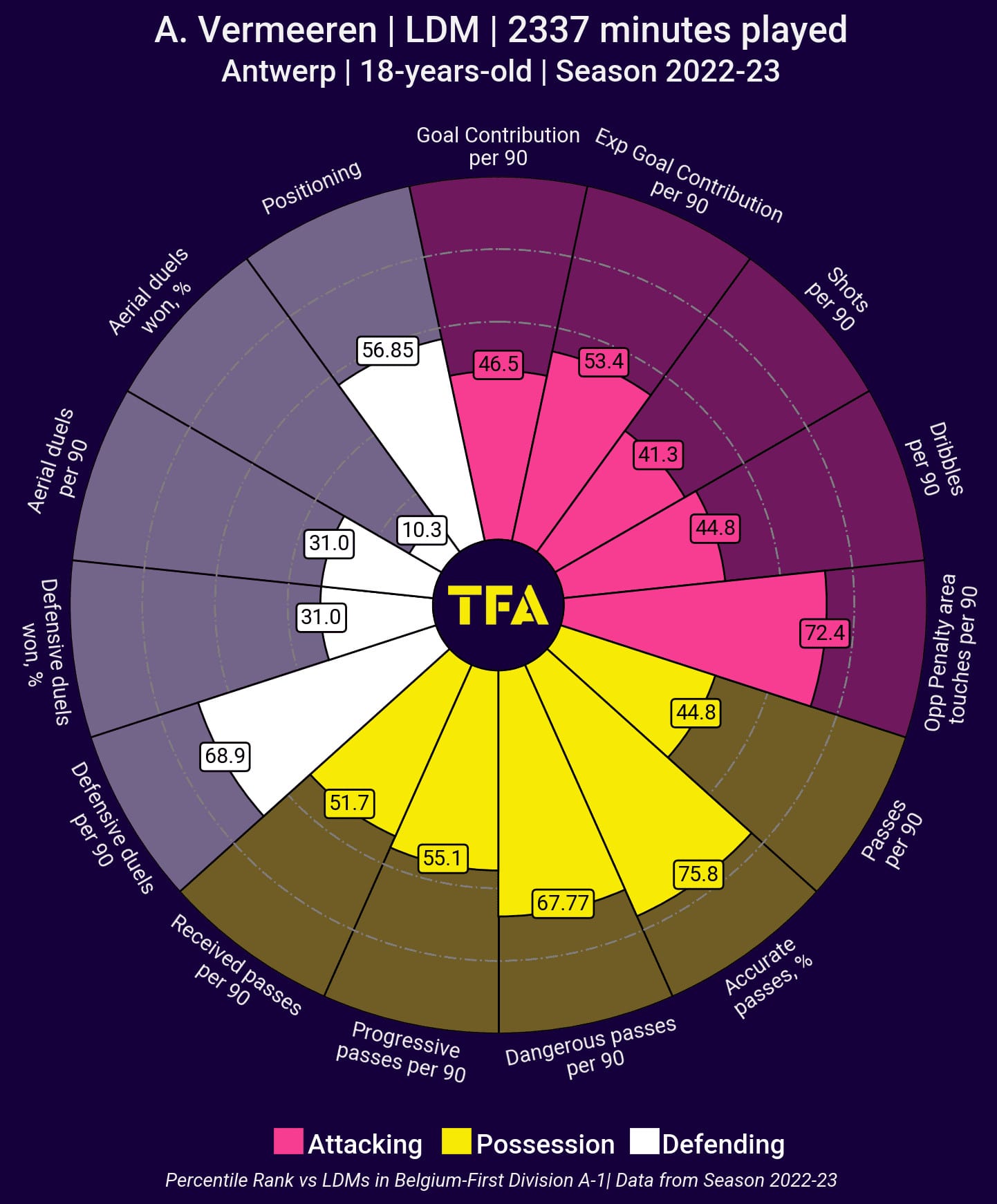
We can see from the pizza chart above that Vermeeren appears to be very good on the ball as he ranks highly in his pass accuracy rating, and he can pick out dangerous passes, which are always beneficial in the attacking phase when the team is looking to create goalscoring opportunities.
He engaged in a fair amount of defensive duels per 90, although the win percentage would need to be higher for him to fit into Brentford’s system; given that he is only 18 years old, perhaps there is a lack of physical strength which influences his performance in this metric.
Vermeeren is a talented young player who has enjoyed a good season with Antwerp, plus as he is only 18, there is plenty of time for improvement, and he would most likely be an astute investment. The Belgian has been linked with the likes of Manchester United in recent weeks, so he will likely be on the move over the summer.
Attacking Phase
We will analyse how The Bees perform during the attacking phase of play. Brentford are not a team concerned with having vast amounts of possession; they averaged 43.46% per 90 last season.
Thomas Frank focuses on making it count when they recover the ball. Brentford has been perfecting this for several seasons, and we see a cohesive and dynamic attacking unit spring into life when The Bees are in possession.
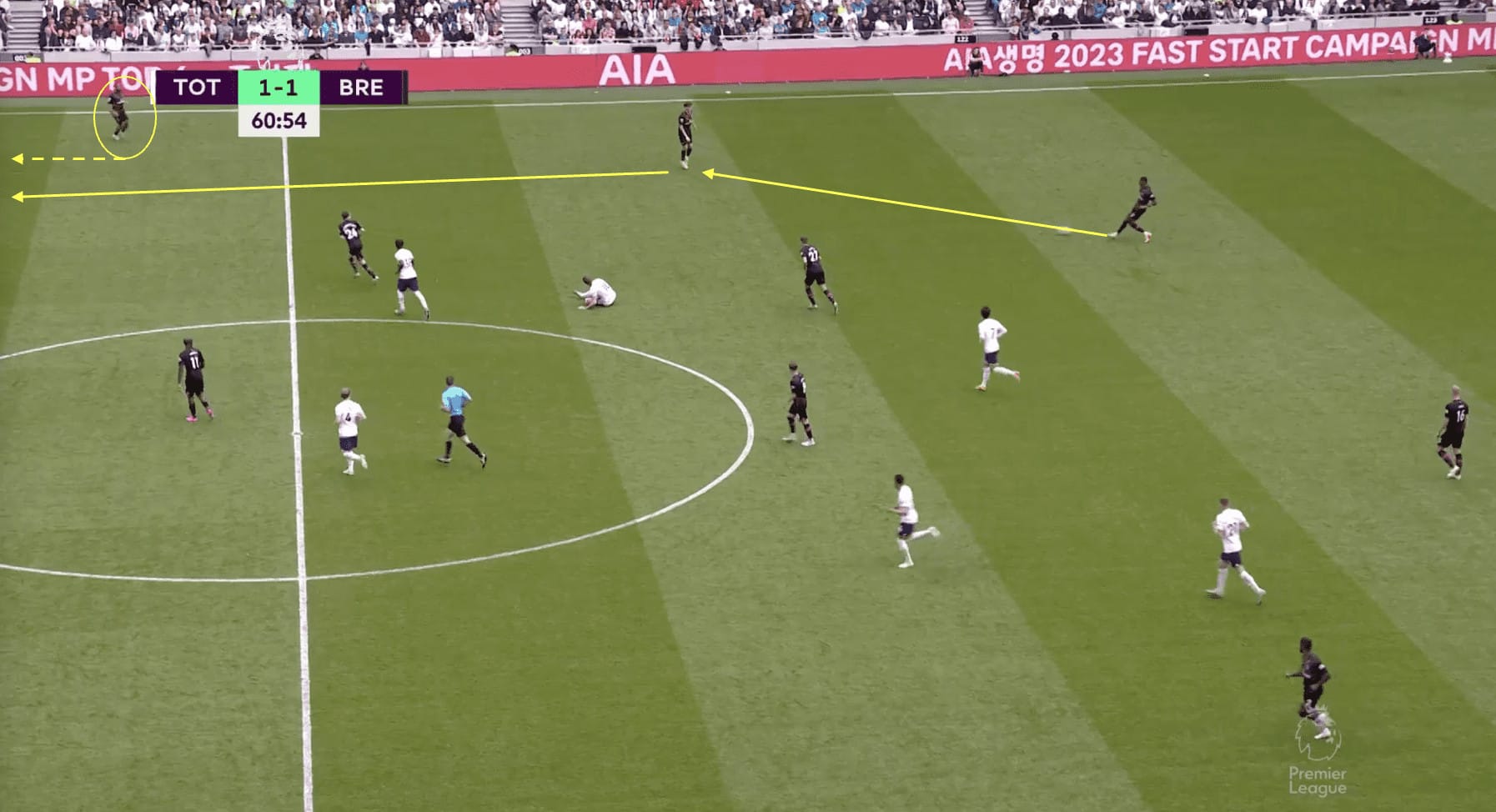
The wide areas are essential for Brentford when building an attack. Whether lining up in their 4-3-3 or 3-5-2 formation, Thomas Frank’s side will primarily look to exploit the wide areas whenever possible. The wing-backs are given licence to get forward as much as possible to add an extra attacking outlet to the play.
In the image above, we can see that Brentford are looking to build an attack; centre-back Ethan Pinnock is in possession and plays the ball into Aaron Hickey. Meanwhile, we can see that Bryan Mbeumo is already anticipating what will happen and is looking to make a run down the wing.
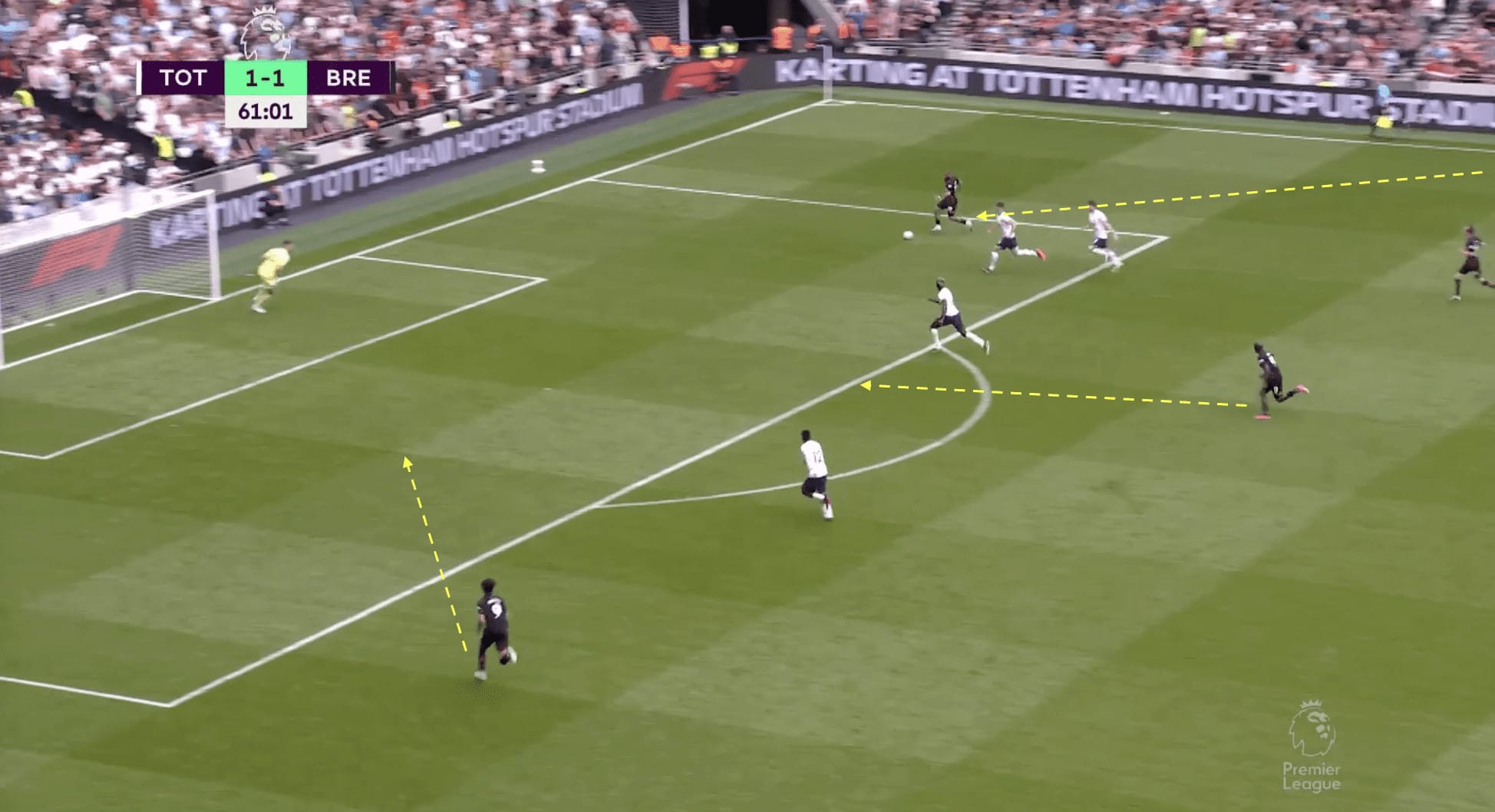
In the six seconds between the two images, we witness a prime example of Brentford’s aggressive, dynamic, and impactful attacking approach. They’re a team that makes things happen on the field.
Hickey skillfully passed the ball to Mbeumo, who then unleashed his explosive pace, leaving the defensive line trailing as he charged into the penalty area. In the image above, we can spot two teammates making well-timed runs into the area, providing Mbeumo with options to either square the ball or go for goal himself.
The wide areas serve as a perfect avenue for swift and dynamic attacks, allowing players to spread out and stretch the opposition’s defence, creating gaps that can be expertly exploited. Moreover, this gives Brentford the chance to capitalise on their players’ strengths.
They boast an impressive roster of talent in these regions, including wing-backs like Aaron Hickey and Rico Henry, and attacking players such as Bryan Mbeumo, Kevin Schade, Keane Lewis-Potter, and the formidable duo of Ivan Toney and Yoane Wissa. Each one of them is known for their pace, dribbling prowess, and precise crossing.
By making the most of these attributes, the team can generate more scoring opportunities and keep the opposition on their toes, unable to relax for even a moment. This focused and calculated approach significantly enhances the likelihood of a successful attacking phase of play.
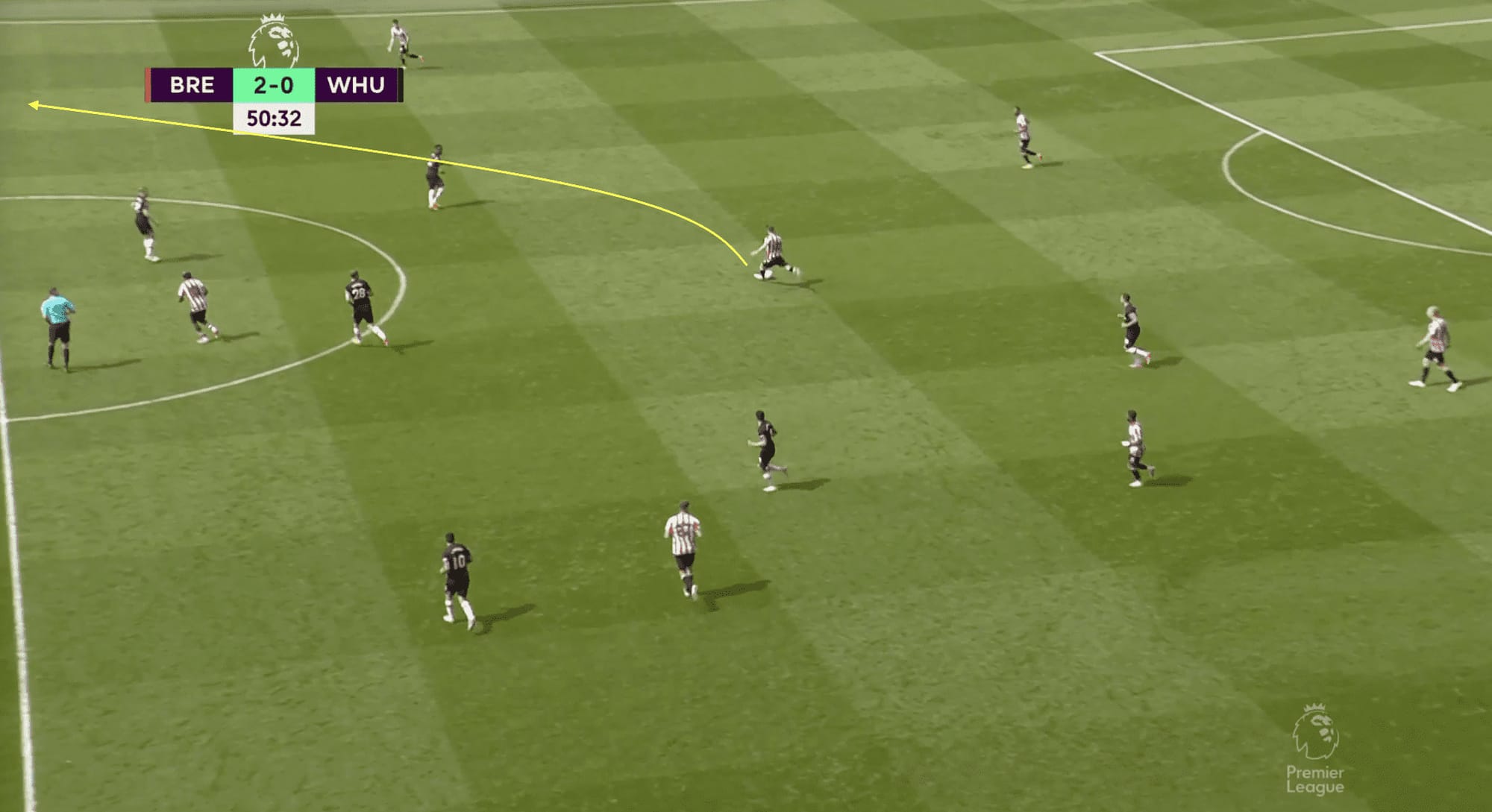
There has been much talk about Thomas Frank’s ‘long ball tactics’ mainly due to their effectiveness. Brentford topped the charts in terms of long passes made last season — 2,312 in total. They averaged 49.21 long passes per 90 with a 56.5% accuracy rating, equating to 15% of all Brentford’s passes per 90 minutes being classed as long passes.
We can see in the images above the long pass originates from the midfield and is targeted towards the wide right area, once again aiming to use the pace of Mbeumo to unlock the opposition’s defence. Brentford tend to sit in a compact defensive shape, as discussed later.
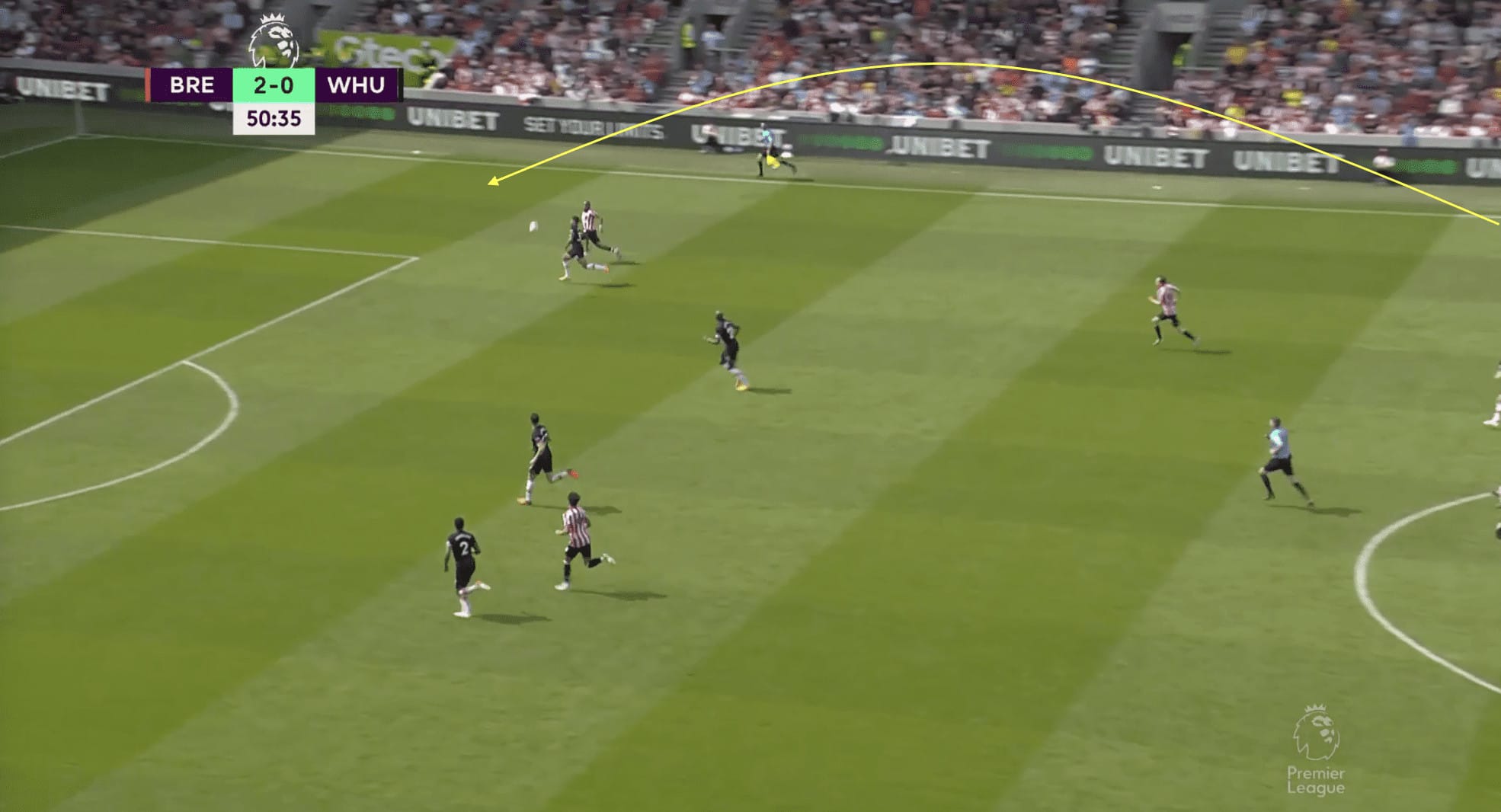
However, once they regain the ball, they immediately aim to initiate quick attacks to catch the opponents off guard. Playing long balls gives the team a direct and efficient way of transitioning from defence to attack. By sending long passes forward, they can quickly bypass the midfield and defensive lines of the opposing team, exploiting the space behind them.
Moreover, this tactic allows them to capitalise on their players’ strengths. Thomas Frank has powerful and accurate passers at his disposal. Mathias Jensen boasted a 75.8% overall pass accuracy last season and a 54.2% long pass accuracy. Vitaley Janelt had an 84.7% overall pass accuracy, with 63.5% for his long passes. Therefore, Brentford is more than accustomed to this style of play.
Furthermore, the team minimises the risk of losing possession in dangerous areas by playing long balls. Instead of trying to build intricate passing plays from the back, which could be intercepted and lead to counter-attacks against them, the long ball approach allows The Bees to clear the ball quickly and shift the focus of the game to the opponent’s half.
Much has also been said about David Raya’s distribution. His long passes or goal kicks often begin Brentford’s transition from defence to attack. The Spaniard’s long passes brought about an accuracy rating of 69.4% which shows that he is more than capable of finding a target with his passing.
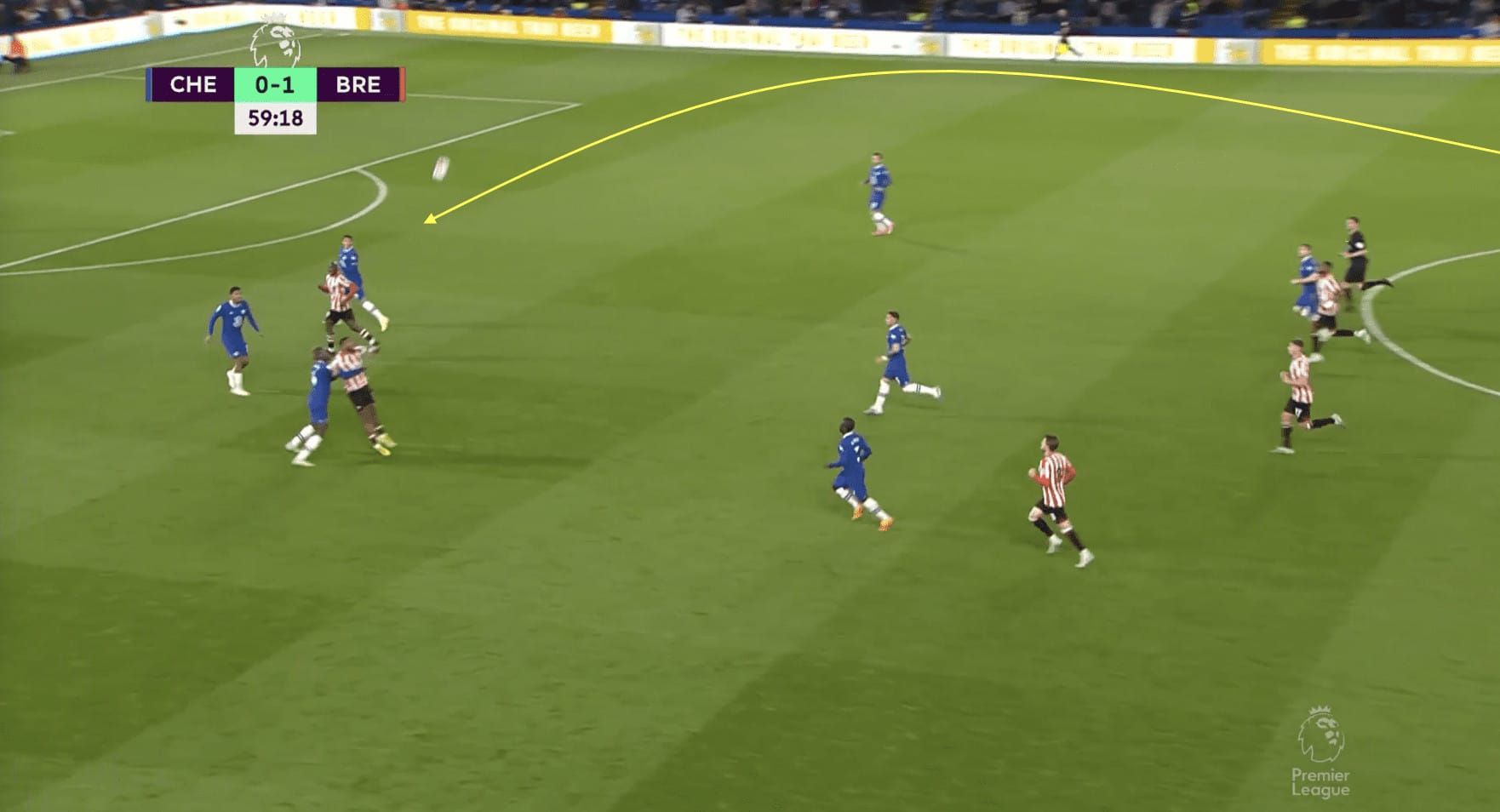
Ivan Toney has so often been that target. As shown in the image above, Raya’s pass is executed accurately, and Toney can use his 1.79m frame to out-jump his opponent. Brentford can catch the opposition off-guard by quickly sending the ball deep into the opponent’s half. As we can see above, they have virtually bypassed Chelsea’s defensive lines and The Blues are caught out of shape.
Additionally, it allows Brentford’s attackers to stretch the play even further. As we can see, Wissa is already looking to make a run beyond the last defender as he anticipates Toney winning the aerial battle with the defender. Plus, should Toney fail to win the header, plenty of Brentford players can battle for the second ball to ensure they stay on the attack.
A final note on Brentford’s attacking play, we must also recognise that Brentford were incredibly inventive with set pieces throughout last season, with 16 of their goals coming from set-piece situations. Thomas Frank’s side is a well-oiled machine at this point. Their principles are ingrained in every player, resulting in the aggressive and dynamic attacking play we expect from this Brentford team.
Defensive Phase
In the defensive phase of play, regardless of whether Brentford are using their 4-3-3 or 3-5-2 formation, should their initial press fail to regain possession, they will mostly look to sit deep, in a compact shape and force the opposition to play around them rather than allowing them to play through the middle. With a PPDA of 10.72 last season, we can infer they are not a team that relentlessly presses. They are more than happy to soak up the pressure and look to counterattack when they regain possession.
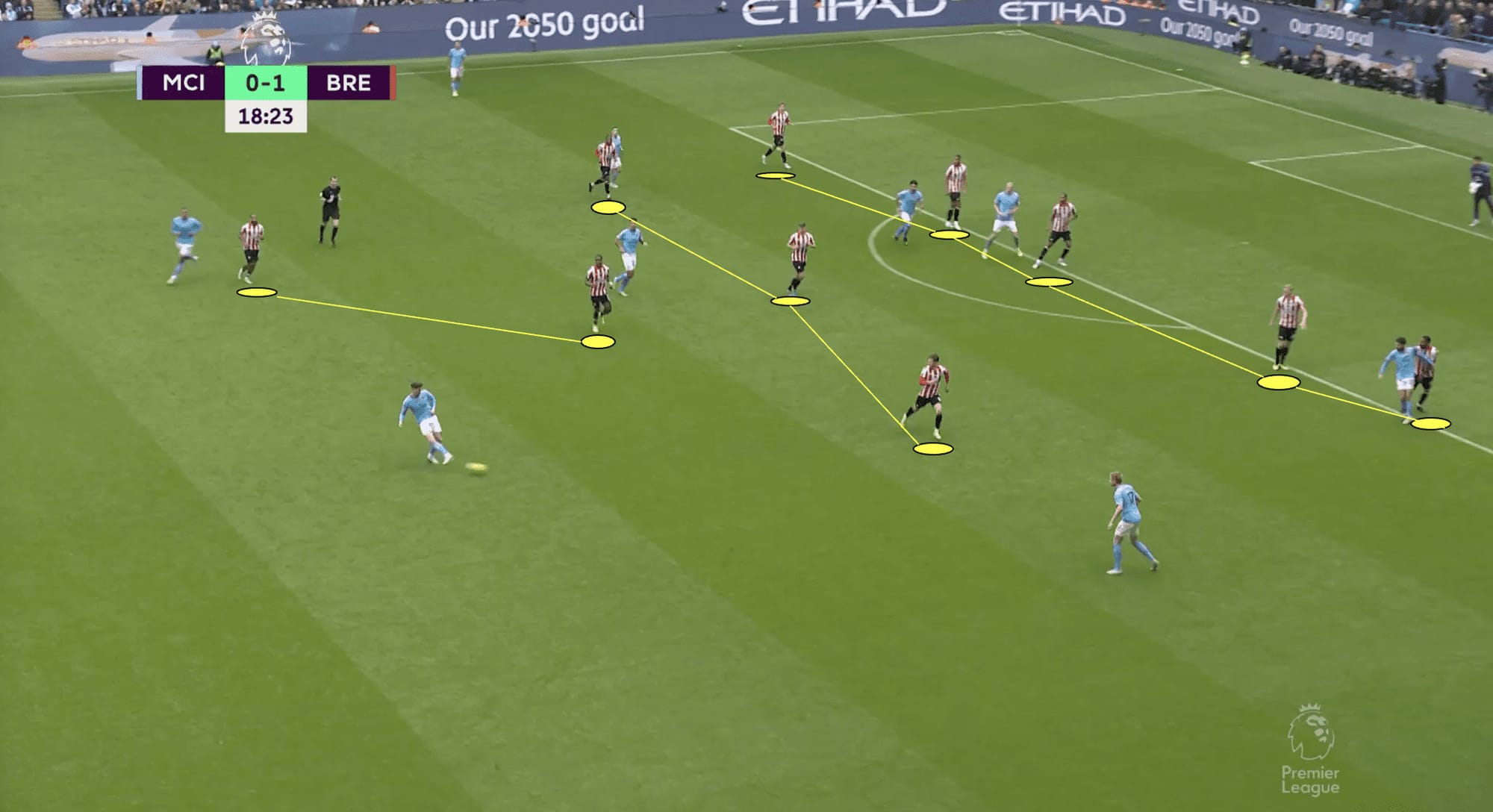
We can see in the image above that Brentford have adopted their compact 5-3-2 shape in the defensive phase. This well-drilled defensive shape reduces the space the opposing team can exploit. When the Brentford players maintain close proximity to each other, it really minimises the number of gaps between the lines.
Therefore, it becomes much more challenging for the opponent to penetrate through their defence. This makes it difficult for the attacking team to find openings and limits their options for advancing the ball into dangerous areas.
Secondly, a compact defensive shape helps cut off passing lanes and deny the opposing players time and space on the ball. As we can see in the image above, the player on the ball only has one available option to pass to (Kevin De Bruyne in this specific scenario).
By positioning themselves effectively, the Brentford players can restrict the passing options available to the opposing team, forcing them to make riskier and less accurate passes. This increased pressure often leads to interceptions and turnovers, providing opportunities for counter-attacks.
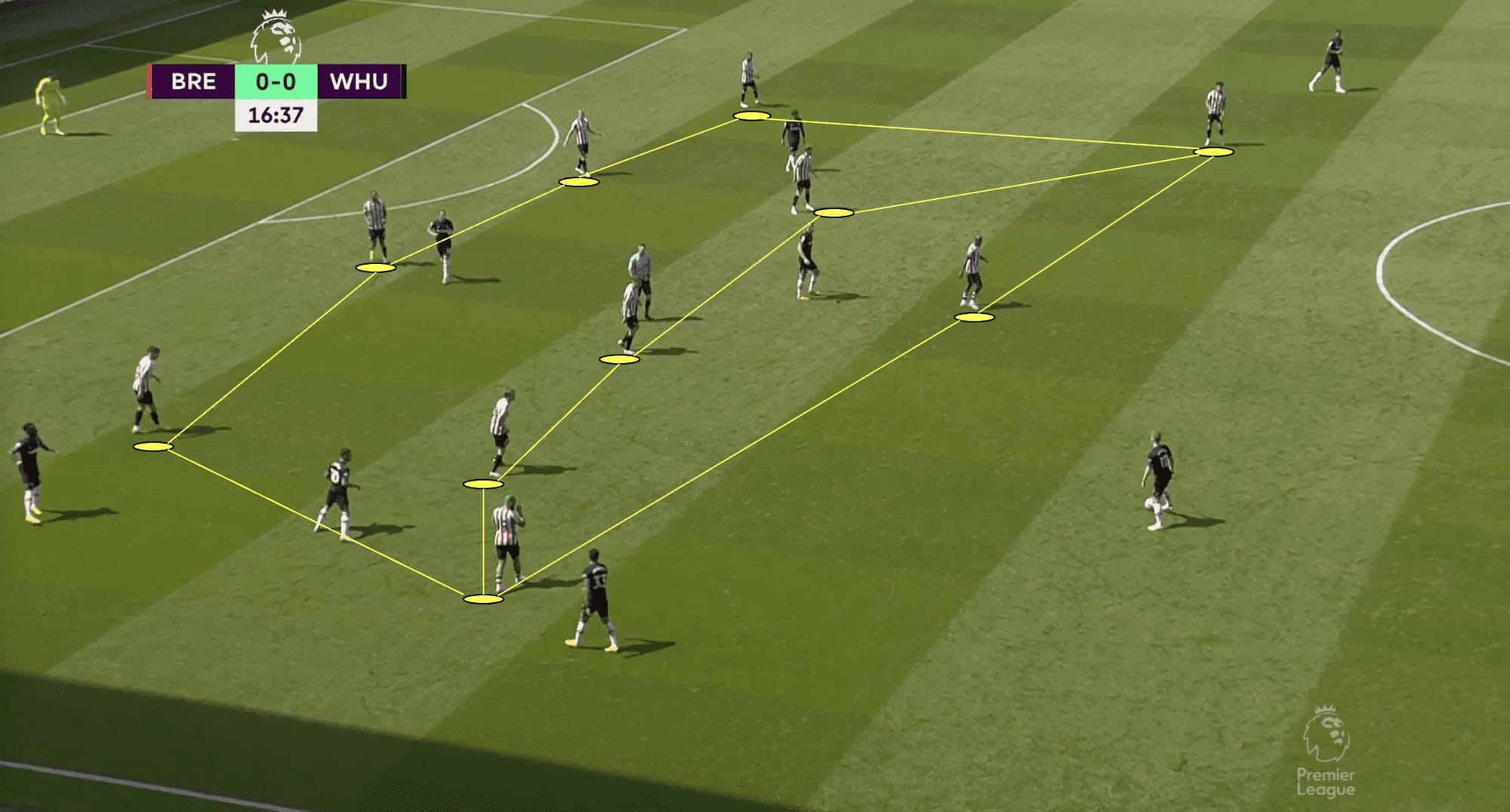
In this instance, Thomas Frank has sent his team out in their 4-3-3 formation, which of course, can quickly become a 4-5-1 in the defensive phase should the wide players drop a little deeper. We can see how little space there is between the Brentford lines.
This makes it harder for the opposition to create overloads in specific areas of the field. By maintaining a dense defensive structure, Brentford can neutralise the attacking team’s numerical advantage in certain areas, making it more difficult for them to break through and create goal-scoring opportunities.
Another advantage is that a compact defensive shape reduces the reliance on individual defensive abilities. Instead of relying solely on individual defenders to make last-ditch tackles or challenges, this well-organised, compact defence ensures that every player shares the workload, making it less likely for individual mistakes to be exploited.
When the Brentford defensive shape becomes so compact, it facilitates quicker and more aggressive pressing. Throughout the game, Brentford suddenly springs into a press, usually initiated by Toney, when the opposition least expects it.
This shows how they are naturally aggressive; on occasions, they press to force the opponent back into their own half and attempt to induce mistakes. This aggressive pressing often leads to the turnovers they desire, often in favourable areas, which allow them to transition quickly into attack.
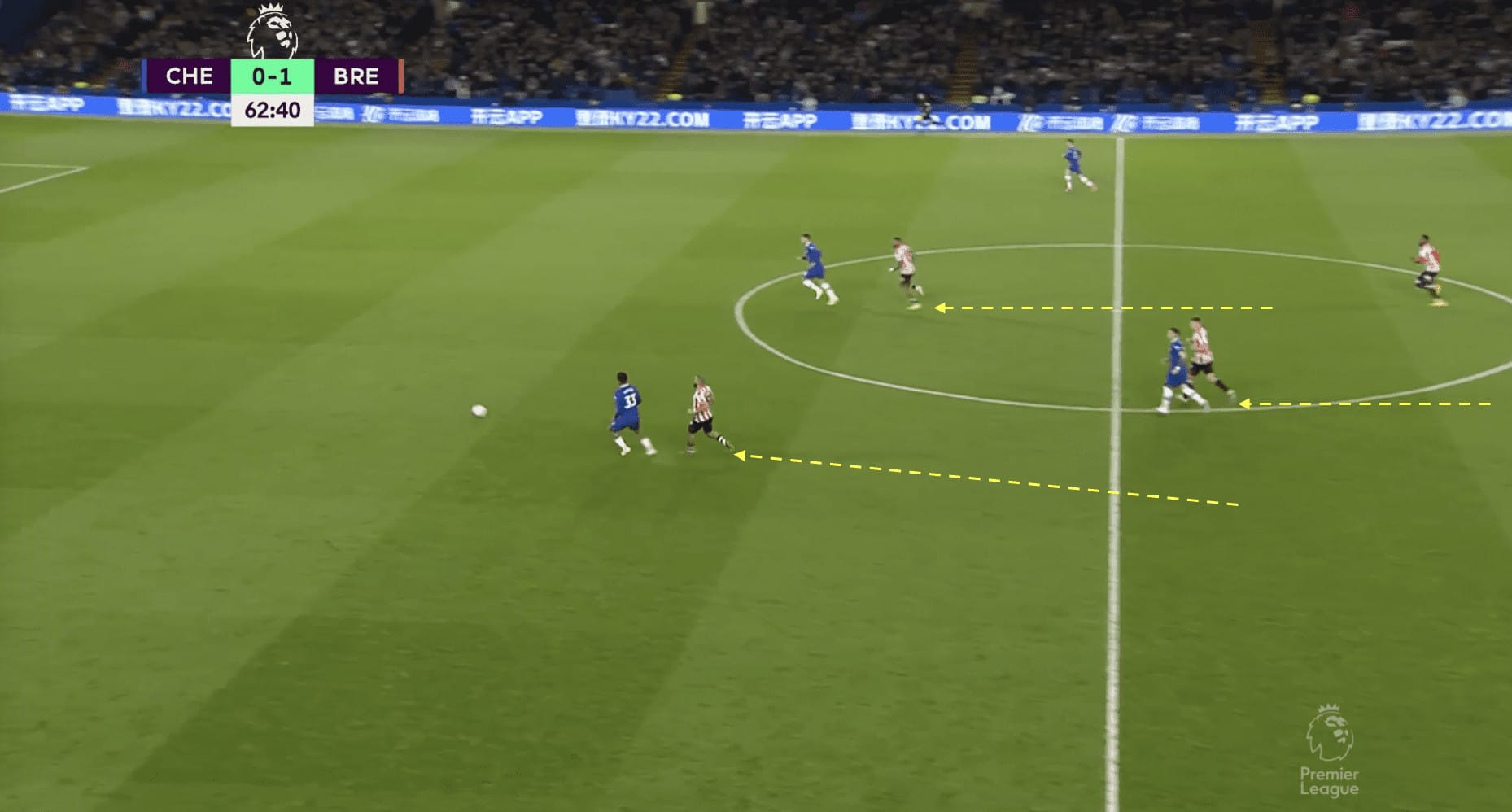
We can see here that Chelsea have been forced all the way back into their own half due to the Brentford pressure. The Bees keep up the intensity and force their opponent to return the ball to the goalkeeper. Effective pressing limits the time and space the opponent has to make decisions on the ball.
This can lead to hurried passes and misplaced balls, increasing the likelihood of Brentford making interceptions and regaining possession in advanced positions. By winning the ball higher up the pitch, the West London team can launch immediate attacks, capitalising on the disarray caused by the pressing.
Moreover, by asking his team to press in the defensive phase, Thomas Frank uses a proactive approach that helps to neutralise the opponent’s attacking threats before they can build momentum. By pushing the opposition away from their defensive third, they reduce the risk of conceding goals and gaining much more control over the game.
Transitions Phase
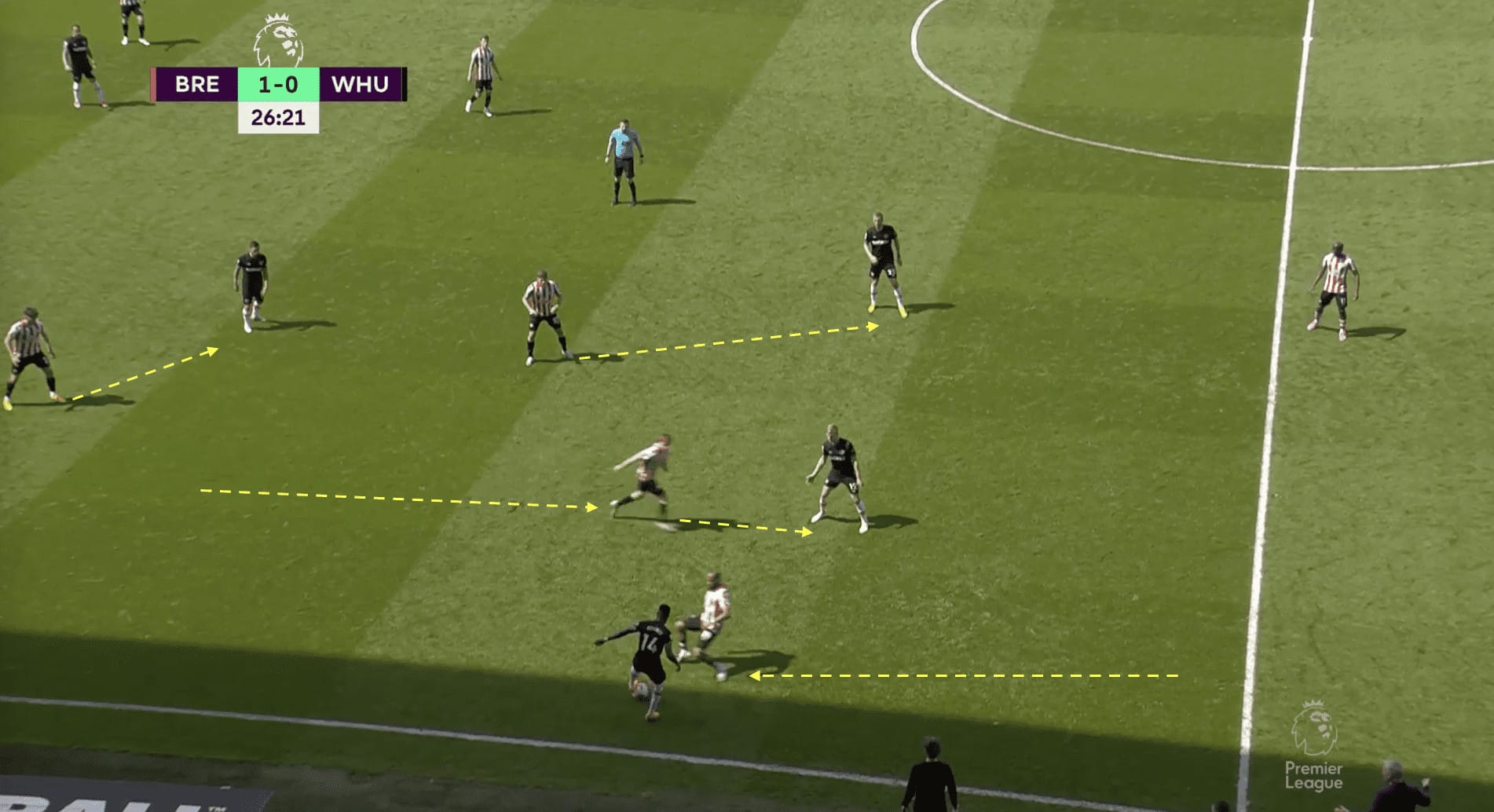
When transitioning from attack to defence, Brentford will typically look to engage in a man-for-man press as soon as possible. We can see in the first image that Brentford have lost possession in their own half and have immediately moved to cut off any passing lanes.
The main aim of this, of course, is to prevent the opposition from launching any sort of counterattack. By preventing the opposition from settling into a comfortable rhythm, the Brentford press limits their time to make decisions on the ball, increasing the likelihood of forcing mistakes or turnovers.
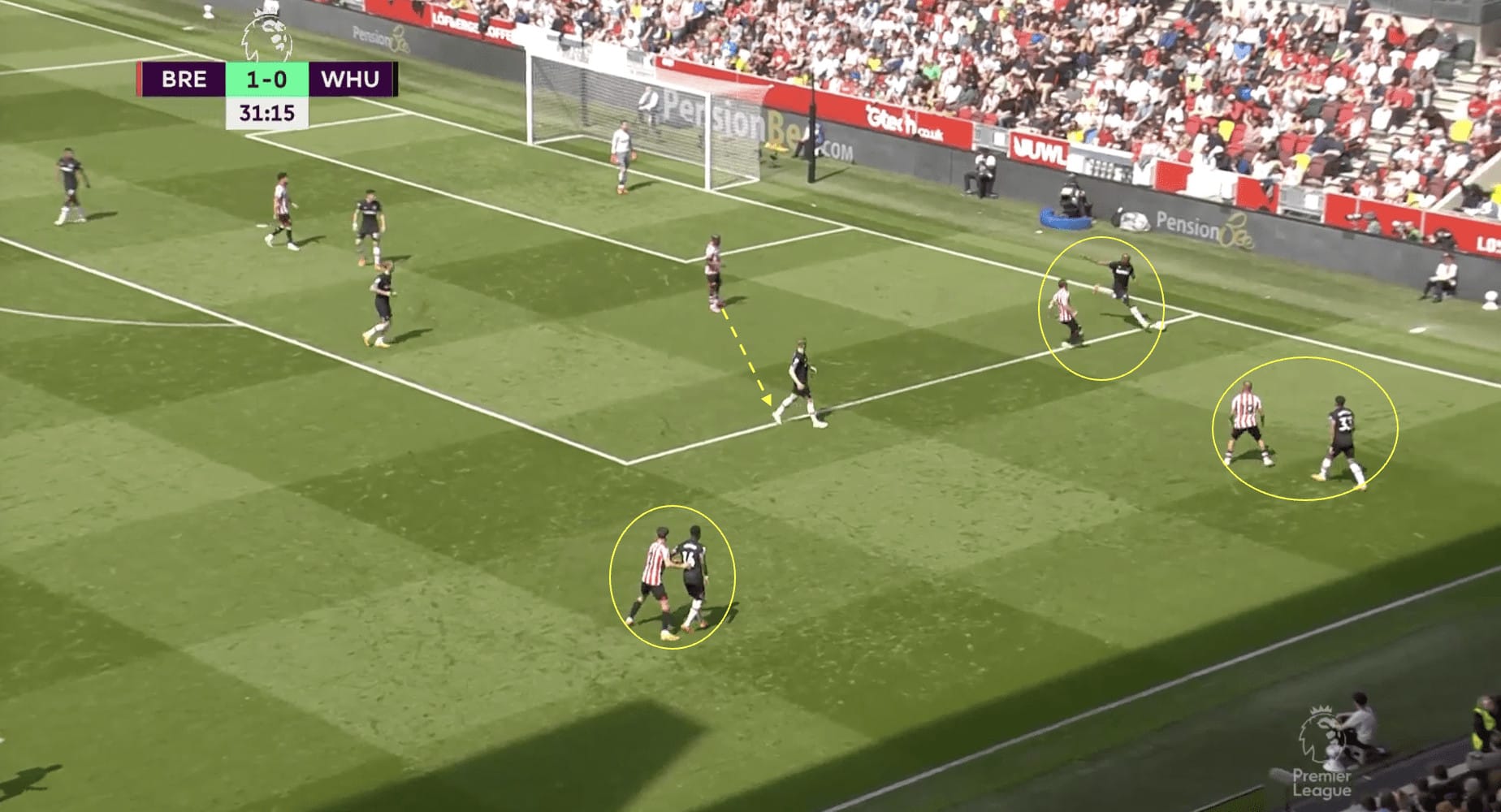
Additionally, pressing right after losing possession allows Brentford to disrupt the opponent’s planned build-up play and force them to rely on long balls or hasty passes, as seen in the second image. Brentford have lost possession and initiated a press which forces West Ham into playing a long ball, increasing the likelihood of The Bees recovering possession.
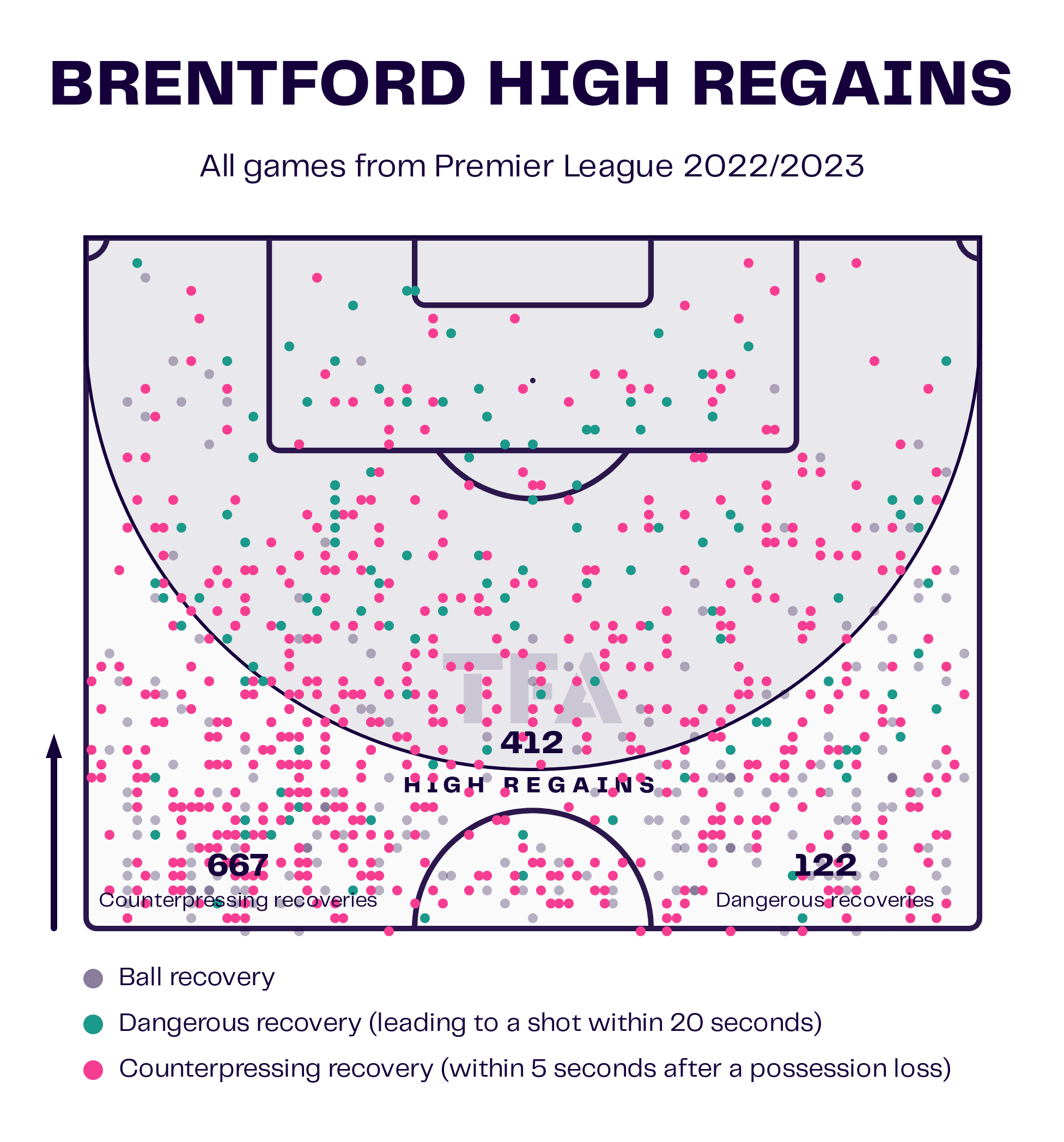
The data viz shows us that Brentford made 667 counter-pressing recoveries last season. By comparison, Arsenal made 637, Liverpool 683, and Brighton 622. 122 of these recoveries were classed as dangerous, meaning that they led to a shot within 20 seconds of the ball being recovered. Additionally, 412 of them were in the attacking third, indicating their commitment to that initial press. If they fail to regain possession in that initial press, they will look to get back into their defensive structure as quickly as possible to prevent a counterattack.
Brentford will typically utilise their long ball tactics when transitioning from the defensive phase to attack, which we have discussed previously in this tactical analysis. We have established that this allows the team to move forward rapidly.
This tactic dramatically reduces the time it takes to transition from defence to attack and keeps the opposition’s defenders on their toes, as they must quickly adjust to the sudden change in play.
This quick transition is an effective way to relieve defensive pressure. When the team is under heavy attack, playing a long pass forward can clear the ball from dangerous areas and allow the Brentford defenders to regroup and reposition themselves.
How will Brentford cope with Toney’s absence?
Of course, when discussing Brentford, we must address the obvious question; will they be able to cope with Ivan Toney’s absence? Brentford’s star man is set to serve an eight-month ban that will see him unavailable for most of the season. It appears that Thomas Frank intends to put his complete trust in Yoane Wissa to step forward and fill Toney’s shoes. This section of the analysis will look into whether the former Lorient man is the answer to Brentford’s problem.
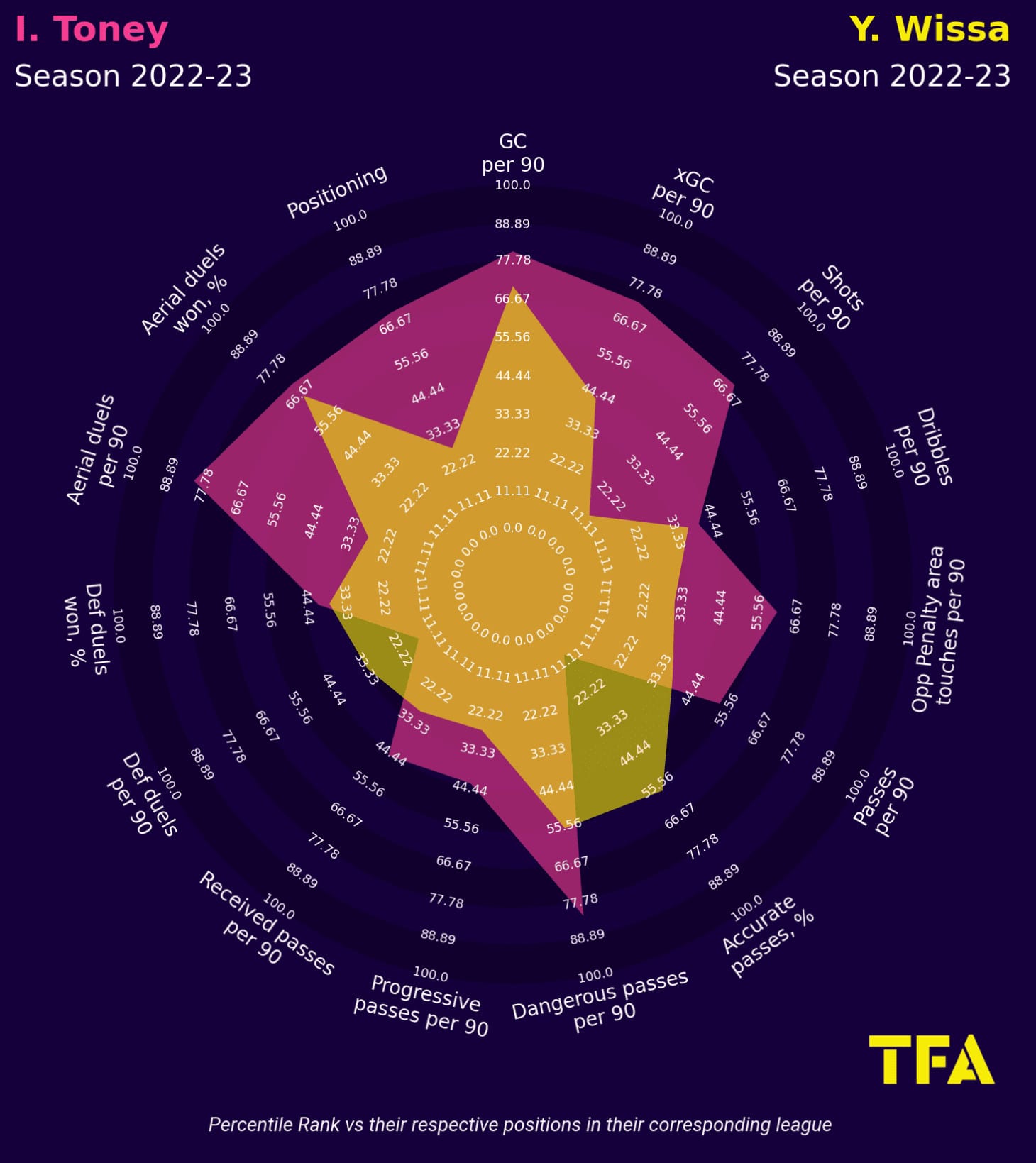
The radar chart above is an excellent place to begin, as it allows us to compare the performances of the two players from last season. We can see from the radar that the two are not too dissimilar.
We have to acknowledge that Ivan Toney was the starter for most of the season, although Wissa did chalk up 38 appearances, most of them coming from the bench though. Toney scored 20 goals last season, 14 non-penalty goals, whilst Wissa bagged seven.
From the radar, the number of goal contributions per 90 for both players was similar. Toney clearly took more shots per 90 which is no surprise given his game time, in addition to the fact that Wissa was sometimes used in a left-wing role by Thomas Frank.
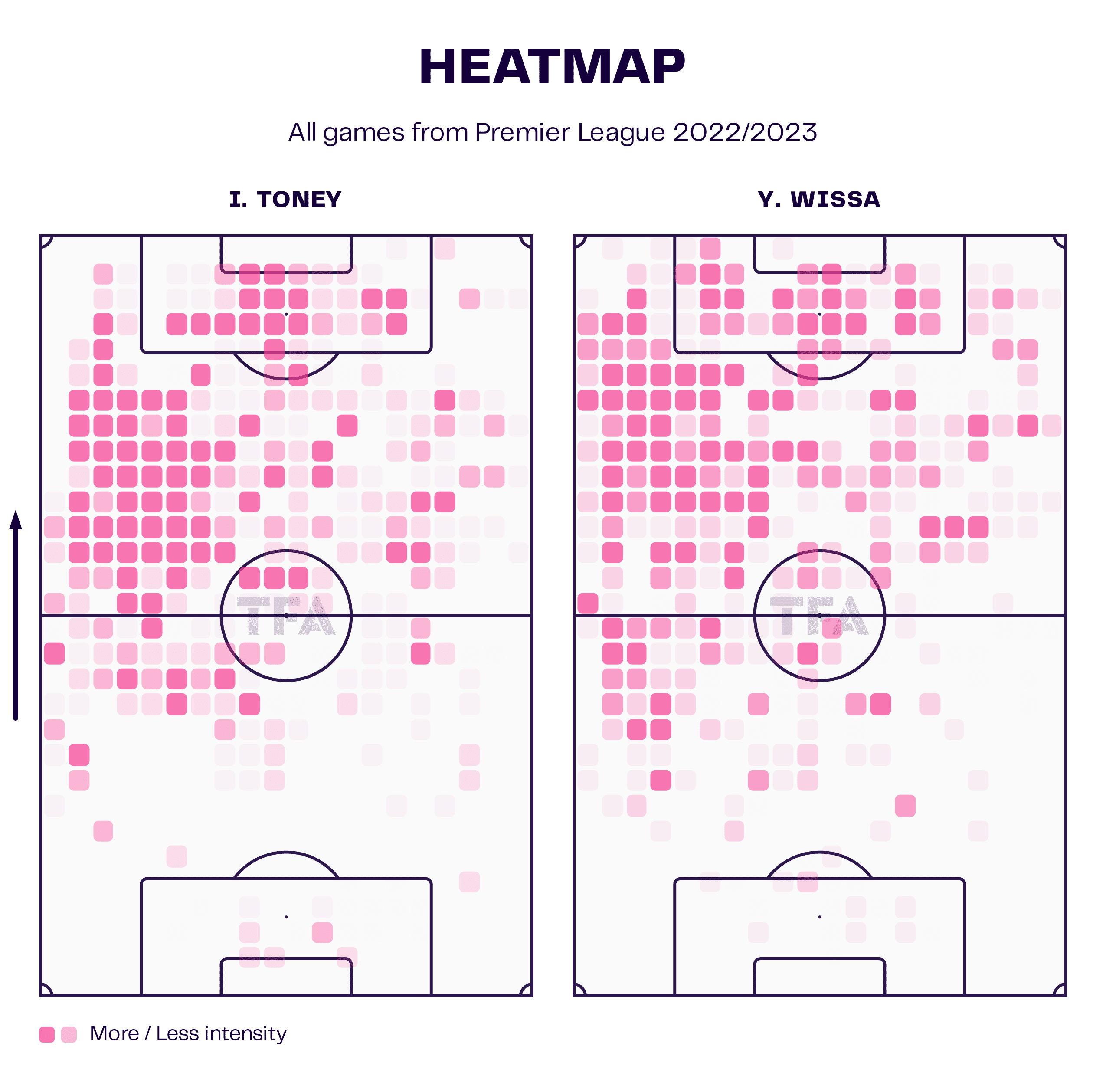
Furthermore, if we look at the heatmaps of the two players, we can see that they adopt very similar positions on the pitch. Both players are very active in the penalty area, as expected. Additionally, both players like to occupy the left half-space, with Wissa just tracking back that little bit more defensively.
With Ivan Toney standing at 1.79 metres tall, he is far more suited to being used as a target; not only is he the taller player, but he also possesses a better jumping reach in order to flick the ball on. Wissa, who is a little shorter at 1.76 metres tall, is more likely to drop deeper into the midfield areas in order to attract the attention of the opposition defenders, which can create space for the wide players Mbeumo and Schade to make those runs down the wings to latch onto a long ball from Brentford’s midfield.
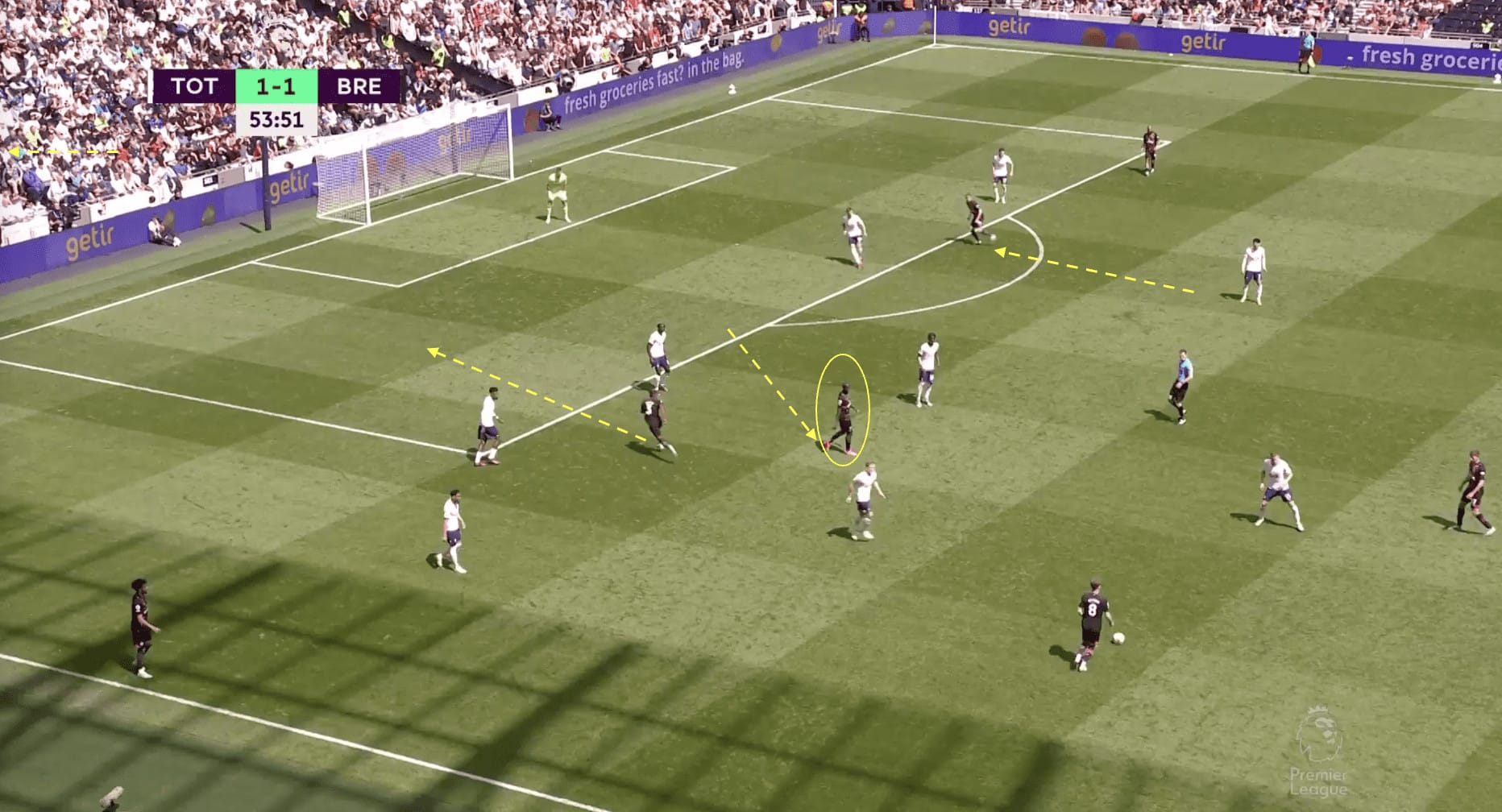
We can see in this image as Brentford are looking to build an attack, and Wissa has dropped a little deeper, which means that he is available for the short pass if required. This does mean that there are very few Brentford players in the penalty area. Wissa’s tendency to drop deeper in the attacking phase requires other runners from midfield or the wide areas to make excellent movements into the area.
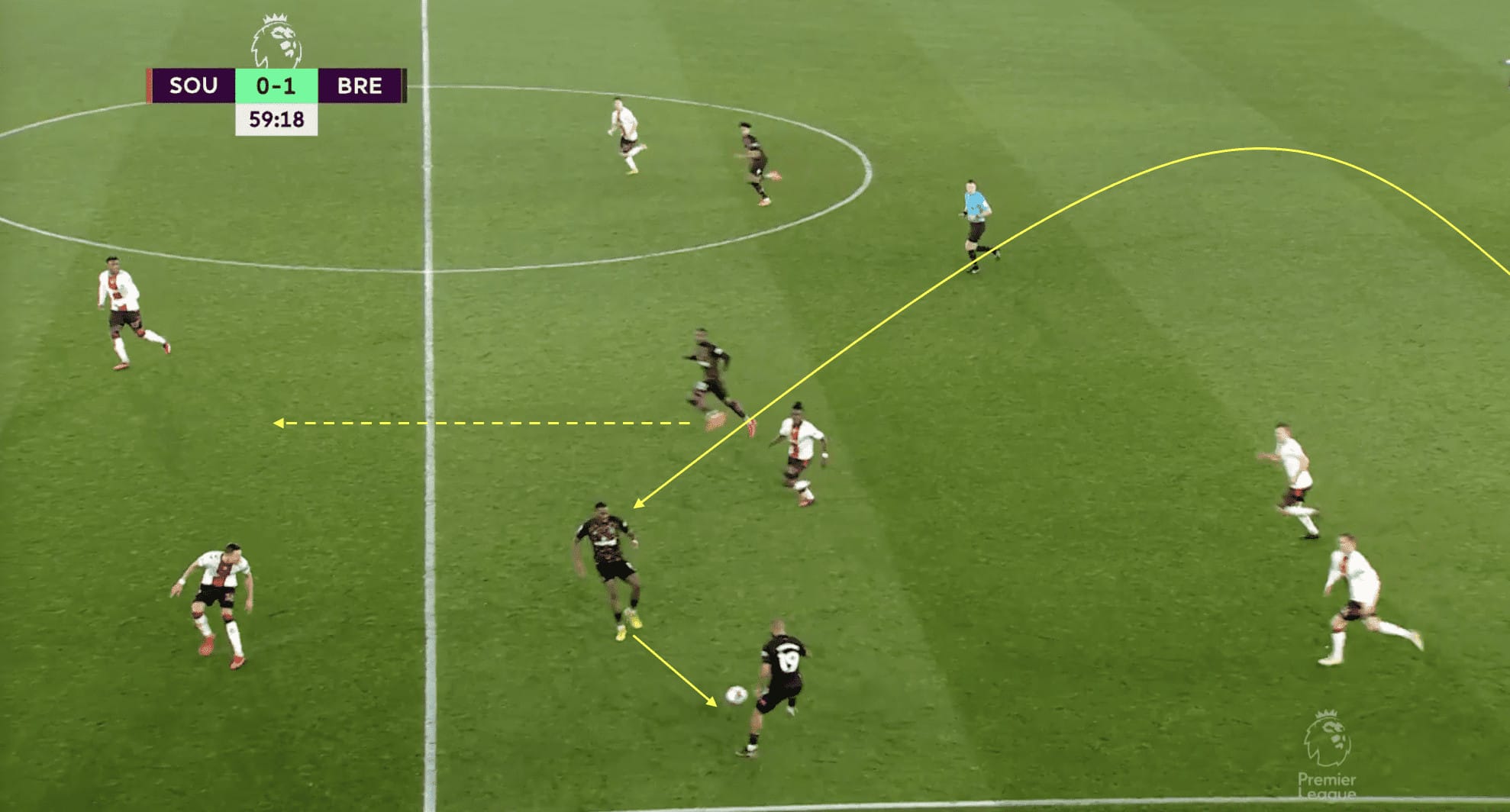
Moreover, we can see here that Toney has dropped deeper and has been used as a target for a long pass. The England forward often comes back to act as the link between defence and attack. Here he is able to knock the ball down to Mbeumo whilst runners from midfield get forward at speed.
However, when Wissa plays as the centre forward, usually what happens is that he will drop deeper, but the passes will be launched to the wide players who are usually making runs in behind.
Thomas Frank has a specific way of playing, and this is certainly ingrained in this Brentford side. It’s highly unlikely we will see him change the way the team plays, instead, it’s far more likely that Wissa will be given the opportunity to step up and be the leading man for the team.
Of course, there are subtle differences between Wissa and Toney, but overall, it appears as though Yoane Wissa is more than adept at stepping into Toney’s shoes.
Key player
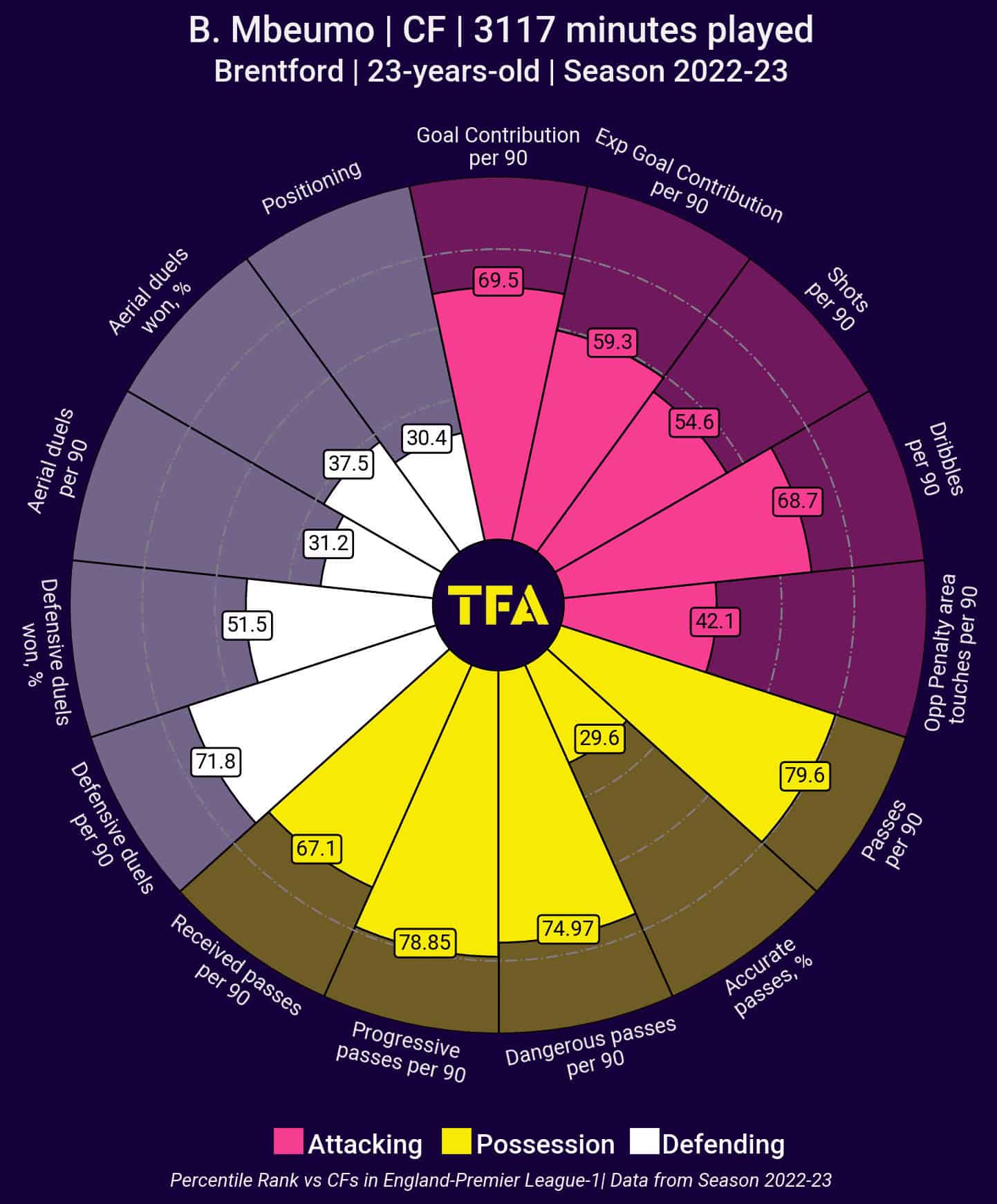
It’s highly likely that Brentford will be relying on Bryan Mbeumo to produce some moments of magic next season. With all the talk surrounding Toney’s goalscoring performances last season, the Cameroon international’s effectiveness almost went a little unnoticed.
Mbeumo scored nine league goals last season, the most he has ever contributed in the Premier League. He also proved to be integral from a creative sense as he topped the club’s assist charts as he set up eight goals for his teammates.
From the pizza chart above, we can see that Mbeumo exceeded his expected goal contributions by a fair amount, so we can infer that he was clinical and effective in the attacking phase last season.
He averaged 3.72 dribbles per 90 with a success rate of 53.5%, indicating he is comfortable on the ball and, for the most part, an adept ball carrier. We can also see that he contributed a high amount of dangerous passes per 90, which ties in with his creativity.
Bryan Mbeumo also contributed to Brentford defensively; fitting with Thomas Frank’s philosophy, he works for the team. He averaged 4.36 defensive duels per 90, winning 55.6% of his defensive duels overall. The former Troyes man has proven to be a very astute signing for Brentford; at only 23 years old, he will likely continue to improve.
One to watch
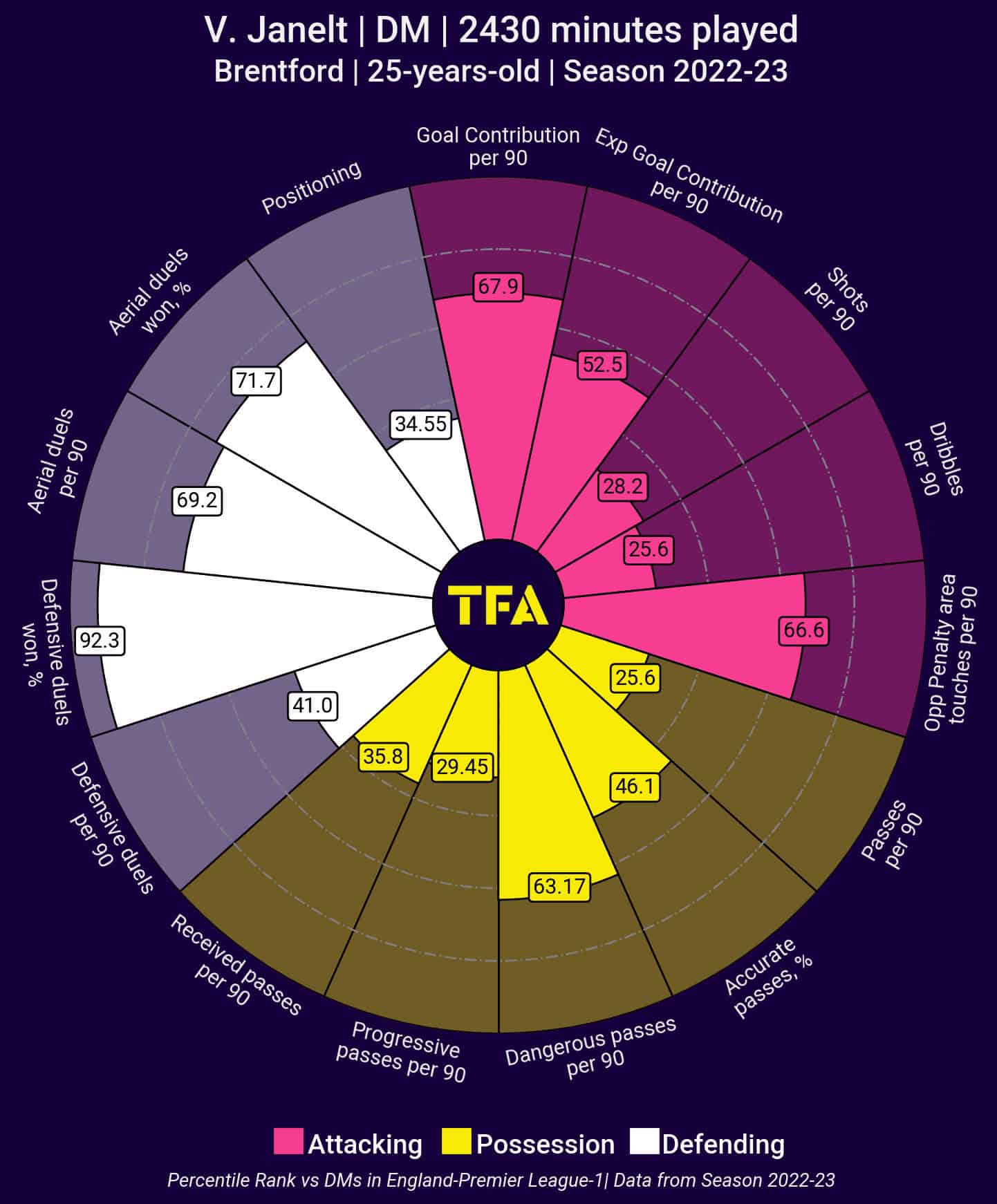
When we talk about Brentford, the likes of Toney, Mbeumo and Ben Mee are always mentioned as being among their most important players. Vitaly Janelt’s contributions often go unnoticed, but that does not mean he is not among The Bees’ most vital players. We can use the pizza chart to analyse his performance compared to fellow Premier League players playing the same position.
Janelt is typically deployed as a defensive midfielder at the base of Brentford’s midfield trio. We can see from the pizza chart that he won the majority of his defensive duels, averaging 6.37 per 90 with a 68.6% success rate. He has become integral to stopping the opposition’s attack with his physicality and strength.
Additionally, during last season, the German was pretty good in the aerial battle as he 54.4% of his aerial duels.
Janelt also contributed to the attack with three goals and one assist, and we have previously mentioned how vital his passing contributions have been to Brentford. Just to go into some further detail, Janelt averaged 4.44 passes into the final third per 90 with a 70% accuracy rating in addition to 1.85 passes into the penalty area per 90, which tells us, as much as his defensive work is vital to the way Brentford play, his attacking play appears to be equally as important. Vitaly Janelt is the heartbeat of this Brentford team.
TFA Verdict: 13th
Another season without any relegation worries and a few more big-name scalps will be a success for Thomas Frank – especially if they can overcome the lack of Ivan Toney for the first half of the season. Dropping from 9th to 13th will be far from a disaster and another top 10 is not a complete pipe dream.





Comments